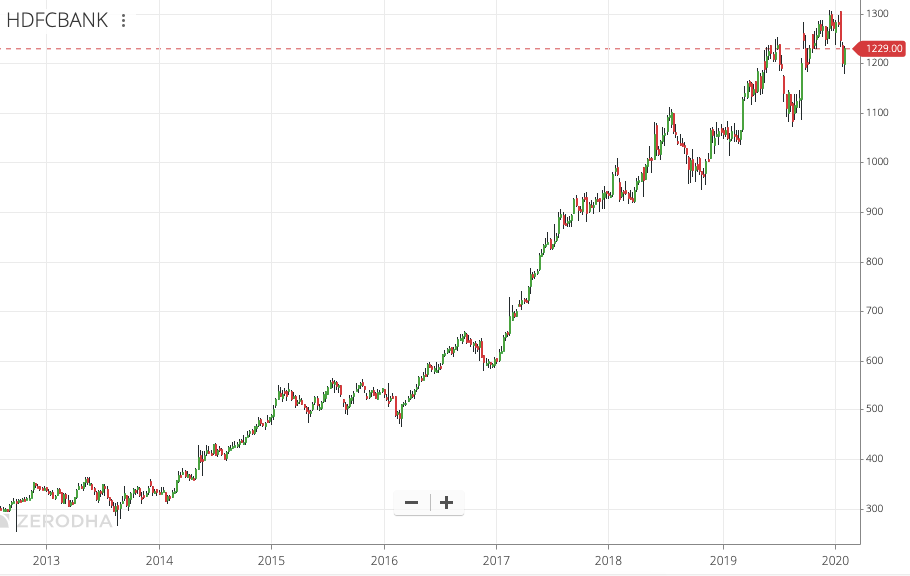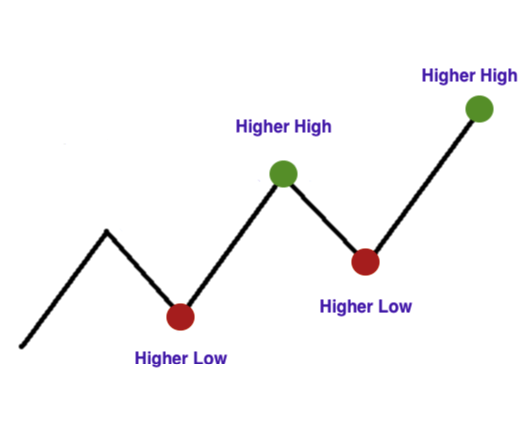There are two types of trends – Uptrend and Downtrend. A stock is said to be in an ‘Uptrend’ when the direction of the price movement is upwards.
When the price moves in the opposite direction i.e downwards, the stock is said to be in a ‘Down Trend’.
When the price is neither going upwards or downwards, it’s called ‘Side Ways’ movement.
This article will help you understand ‘Uptrend’ and ways to identity stocks that are moving upwards.

The chart above is of HDFC Bank from 2013 to 2020 i.e 7 long years.
Which trend do you think the stock is in? Uptrend, Downtrend or Sideways?
Even a young school going child, without any knowledge about stock market, will be able to tell that the stock has been steadily moving upwards. From ₹ 250 per share in 2013 to ₹ 1230 in 2020, HDFC Bank has been on an uptrend for several years.
Higher Highs and Higher Lows
No stock moves straight in one direction. The price will often go up and fall, before going up again.
One of the easiest ways to identity an ‘Uptrend’ is to see if the stock is going above its previous high and not falling below its previous low.
This is often referred to as ‘Higher Highs and Higher Lows’ – which is very similar to a staircase that goes up.

Some important points:
1. Always buy stocks that are in an uptrend. Buying stocks that are in downtrend is like swimming against the tide at the beach. It’s difficult and the chance of drowning is high. It’s the same with stocks. A stock that has fallen from 100 to 80, can also fall to 50 or lower. Inexperienced investors, especially, will keep averaging downwards and wait for reversal. These kind of stocks will test your patience and you won’t be able to make real money out of them. Most investors sell out when they get their buying or average price back. Hence, go with the tide and buy stocks that are in long term uptrend.
2. Never sell shares that are in long term uptrend. Suppose you buy a stock at ₹ 100 and it goes to ₹ 200. You should avoid selling it even if your fundamental analysis says the stock is expensive. Remember, the market can surprise you on the downside and it can shock you on the upside too. A stock that rose from 100 to 200 can also go to 300 or 500!
3. Learn to hold and ride stocks that are in uptrend. Hold until the trend reverses i.e changes to downtrend. Learning to hold for long term only comes from experience. Rakesh Jhunjhunwala had first bought Titan shares at ₹ 3, if he had sold them for 100% gains at ₹ 6, he wouldn’t be the richest stock market investor in India today. Resist the temptation to sell for small gains, think big.
4. Learn to buy even after the stock price goes up. Averaging up is better than averaging down. Suppose an investor bought Bajaj Finance at ₹ 1000 per share. He wouldn’t think of buying it again after the stock rises to ₹ 1500 per share. Today the price is ₹ 4500 per share. The investor would be in huge gains even if he bought it at ₹ 2000 per share. Averaging up is psychologically very difficult, your mind will not allow you to buy after the price rises. But it’s this quality of buying even after the price rises, which separates the successful investors from the rest.
5. Avoid buying stocks that rise straight up. They could crash equally fast, especially in small cap stocks, where price can be manipulated.. Check the HDFC Bank chart above. The stock has moved slowly, but steadily. You should look out for 45 degree angle movement on the chart, not stocks that rise straight up in 80 degree angle.
6. Long term investors should look at long term trends i.e select monthly chart. Medium term investors should ideally analyse the trend on weekly chart. More on the different types of charts in another article.


Leave a Comment